| |||||||
| Search Forums |
| Advanced Search |
| Go to Page... |
 |
| Search this Thread |  9,383 views |
| | #1 |
| BHPian Join Date: Aug 2022 Location: Bengaluru
Posts: 54
Thanked: 269 Times
| Raisen, Malwa and Nimar Road-Trip For several decades I have been making entries in my travel diaries as notes for my reference, but on the flipside hand written notes cant be shared with fellow travellers. Sharing one such travel experience with you. We undertook this journey in March 2022. Devil is in the details, some information for the future travellers on this route. The journey was done in a Mahindra Scorpio. The trail 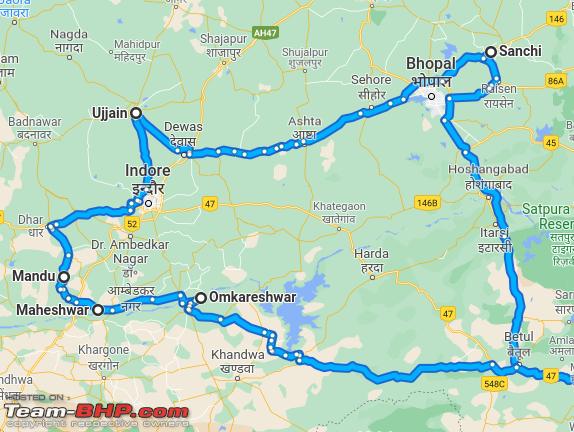 Hotel details: MP Tourism is the crown jewel of India's tourism industry. Sanchi: MPT Gateway Retreat Ujjain: MPT Shipra Residency Maheswar: MPT Narmada Resort Omkareshwar: MPT Narmada Resort (only vegeterian food is served) Parking details: In MPT properties it is open air parking. Ujjain Mahakaal: Big paid parking place on the main road before entering the pedetrian road that leads to the temple. Harsiddhi Mata mandir and Ram ghat are walking distance from there. Omkareshwar: Parking available on the banks near Gaumukh ghat, one can ask the locals there, that's the nearest to the river bank. Be careful with the road that leads to that parking as it's narrow with a steep edge. There are other places to park but that's far away from the river banks. ASI managed monuments in Mandu, Vidisha and Sanchi have enough parking lots but I forgot whether it's paid or not. One can buy the entry tickets online by scanning the QR code as well - it's convenient and a bit less than the marked entry price. Majhi details around Narmada: Hotels have contacts of several majhi-bhai. Fuel bunks: Besides NHAI roads, they are available along the state highways and the towns one passes through. Cards and UPI are accepted. Bunk toilets are clean and ladies can use it. SBI ATM available in all major towns. Forest roads: While going through forests avoid high speed as the roads are not banked along the curves. Also the edges of the road are steep in some places, if the wheel fall off the road there are chances of the car skidding away from the road. In case of urgency to relieve oneself, avoid getting off the road, the dry leaves beside the road are at times a resting place for snakes. During daytime they go underneath the carpet of dry leaves to avoid the heat. Best is go to the back of the car and relieve. For ladies, open the front and rear door on the left side and use the space in between, that's what the ladies in my family does. It's safe and the doors acts as a decent modesty cover. Highway eateries: Decent places for families as long as you stick to simple menus of daal-roti. Everything is freshly made in front of the customer. As a rule be it on the road or railways, I prefer vegetables and eggs as they are safer (difficult to adulterate), and avoid milk products like paneer (high chances of adulteration) and meat (quality and date of expiry). Besides, it been over a decade I boarded a train. You can paste the names as is on google map. Hyderabad-Nagpur route: The Malgudi A/C, Kamareddy, Telangana 102kms from Hyderabad Rajasthani Sharma Veg Dhaba, Gudihathinur, Telangana 289 kms from Hyderabad SharmaPunjabi Dhaba, NH 44, Adilabad(U), Telangana 294 kms from Hyderabad Rajasthani Chaudhary Dhaba Patanbori, Maharashtra 330 kms from Hyderabad Hotel Ashoka Jamb, Maharashtra 437 kms from Hyderabad Nagpur-Sanchi route: Betul area Vansh Dhaba And Family Restaurant, Near, NH47, Balajipuram Road, Hanotiya, Madhya Pradesh 173 kms from Nagpur Lucky Da Dhaba And Family Restaurant, near Elbi Lawn Hotel, Hanotiya, Betul, Madhya Pradesh 174 kms from Nagpur Obaidullahgunj area MPT Highway Treat, Bhimbetka, Bhaiyapur, Madhya Pradesh 464990 312 kms from Nagpur Within MP, eateries are less on state highways, lookout for MP Tourism's Highway Treat restuarants on your journey route, they are clean and serve freshly made food. Snack shops are available when crossing towns. In general, the rural life spills over to the roads so drive slow in state highways, this is true all over India. Drive very slow if there are cattles on the road, I generally get down and move them myself - surprisingly they oblige thinking me as one of their kind (especially post-liberalisation). Team-BHP road safety (https://www.team-bhp.com/safety) articles are the gold standards for safe driving. A thorough reading is recommended. **** While we witness the battering of the planet every day, witnessing her resiliency in the spring time is embalming. In March-April most of the agricultural fields in India turn golden, soon the harvest will begin and the fields will be readied for the next sowing season. Something which we take for granted... [Wheatfields around Raisen district] 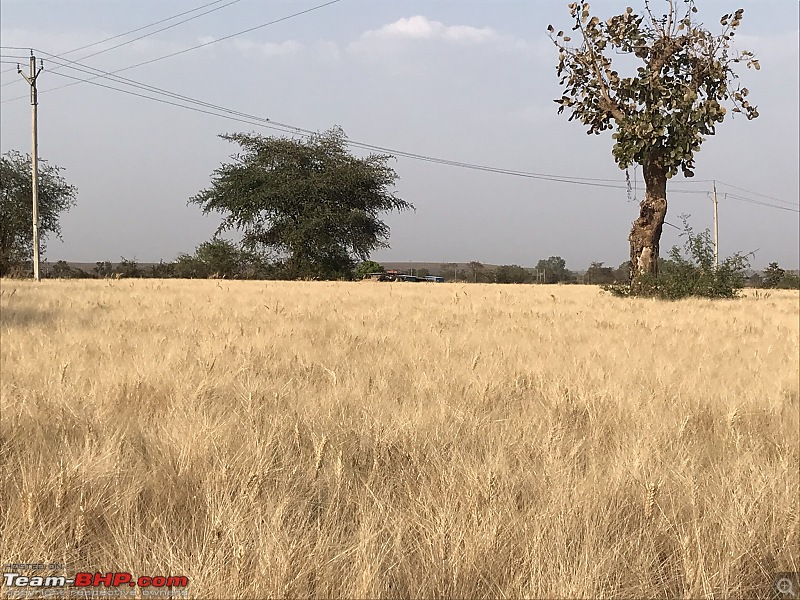 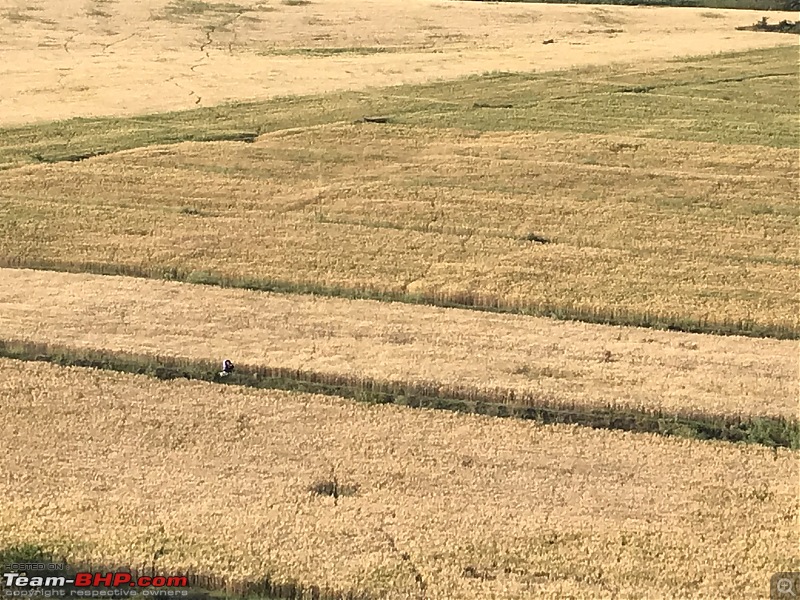 The Narmada basin has an interesting geology, it flows through a valley between two mountain ranges - Vindhyas in the north and Satpura in the south. This sort of formation is technically called a graben (it's a German word like "Karst" a type of rock formation on limestone/marble/gypsum that we find in Yana in North-west Karnataka). Maybe a bunch of German's were first to study it and that's why the German word remained, as opposed to Latin or Greek that dominates nomenclature. I am not a follower of fixed routes, anytime preferring village roads to the monotonic runways of NHAI. For me, from printed road guides to google maps, road trips has fascinated me. It's the best way to know the land and oneself. While one discovers the terrain, under the hood one keeps discovering oneself. My route was to reach Hyderabad by late afternoon, then Nagpur the next day and not to miss saoji non-vegeterian food. The following day drive to Sanchi, seeing Bhimbhetka and Bhojeshwar Mahadev Temple enroute and finally reach Sanchi by 2030 hrs. We had left Nagpur around 0845 hrs. Krishna and Godavari, like most of the rivers in India, was a bit dried up around this time of the year, the water level was just knee deep in some places and we could see many cooling off their heels under the hot sun. After Nirmal and Godavari crossing the landscape became semi arid upto Hinganghat and along the highway I was desparately looking for a tree that could shelter us. I generally avoid eating sit down meals while on the road, just wanted to stop for chai-biskoot and a bidi for myself. I was carrying enough dry food for the rest of the travellers. We were carrying tea in a flask, finally found a tree shade along the highway that could accomodate us. Inspite of so much heat and dryness around, the shade was much cooler and magically a cool breeze comforted us from the distant lands. Besides, those unbriddled peotic expressions will not stop us from cutting them down when the need be. Most of the journey after Betul was through Sal forests and small villages, got a glimpse of Narmada near the Hosahngabad Narmada bridge (now Narmadapuram), the temperature was around 42 degree celsius then. A lot of construction and road widening was going on so had to drive through pebbles, dust and stone chips but the route was refreshing. We touched the western fringes of the Satpura reserve forest while crossing the Tawa area before Itarsi. I dont complain about road quality, roads are just like life's journey - good sections, terrible sections; anyways we will cross it. Bhimbhetka is a poetry on sandstone interlaced by the grafittis of early man who used these caves as shelters. It's one of eight hills around the Ratapani reserve that hosts enumerous cave shelters, only this one is open to us and the rest are out of bounds for modern man. Interestingly the Bhojeshwar temple is also built with sandstone. While I was standing on the hill of Bhojeshwar witnessing the sunset and the cool breeze that accompanied it I was looking towards Bhopal through the smoking chimneys of the factories in the horizon and wondering how it must have been in 1984. The sanstone rocks of Bhimbhetka 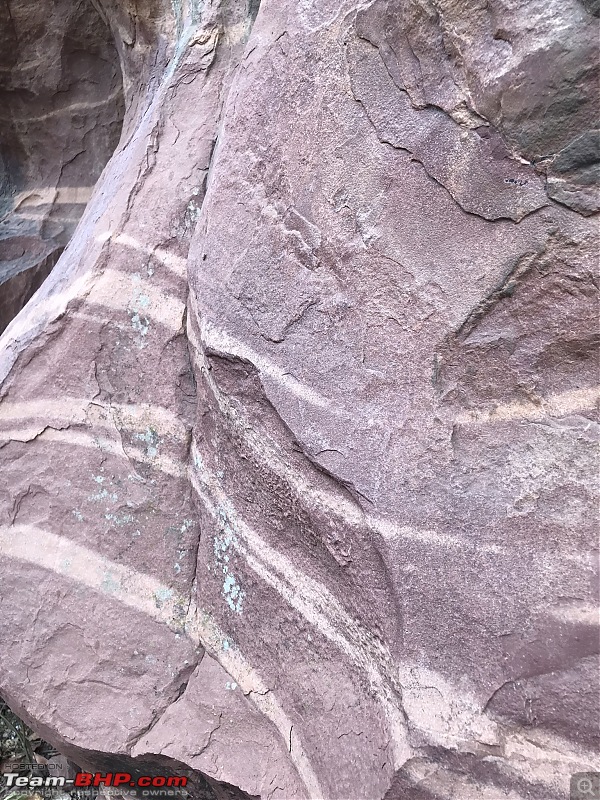 And the prehistoric artwork 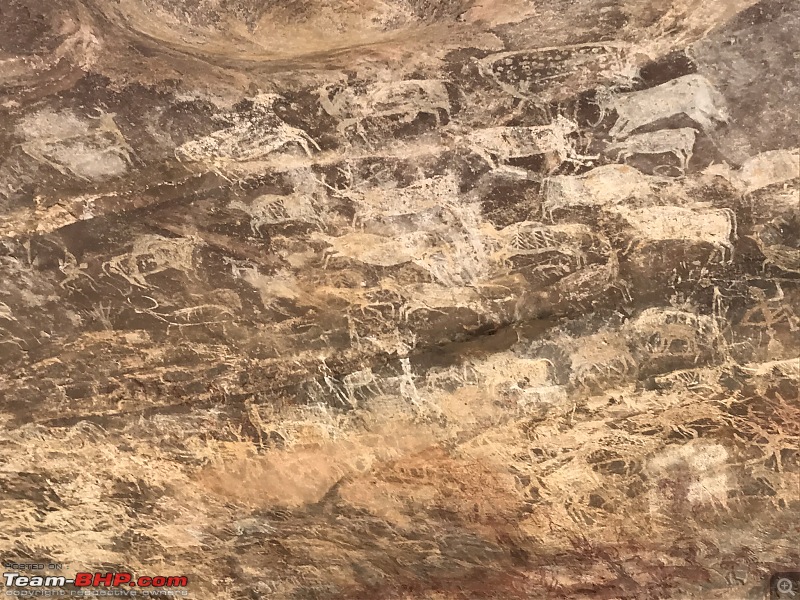 Bhojeshwar Mahadev Mandir, Bhojpur 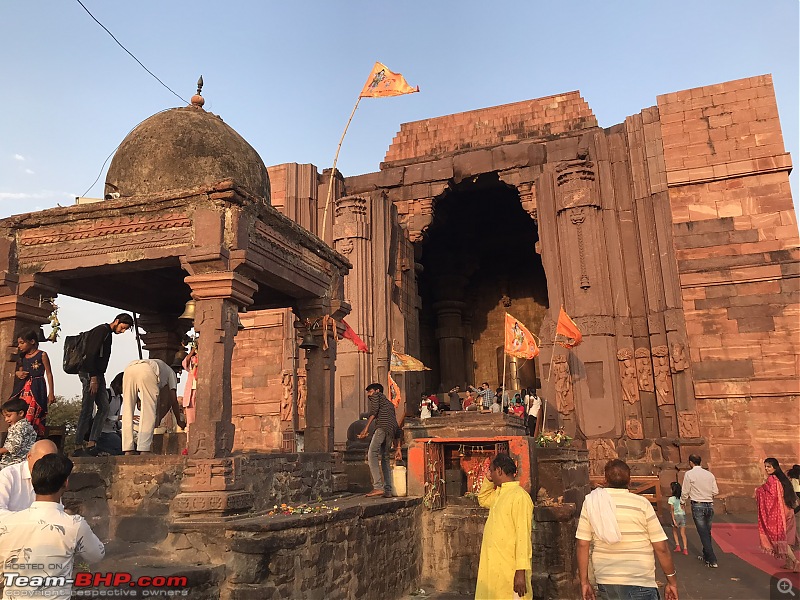 While leaving Bhojpur took an arbitrary road to join the highway. To our surprise it lead us to a road where the Sunday open market was in full swing. I couldnt see the tar road in front of me, there were people all over the road. Bhajji, Jalebi, fruits, vegetables, utensils, clothes, farming tools, household tools - just anything one would need was being sold there. I rolled the window glasses down and drove the car at the pace of the people in front without imposing our presence and insensibility of needlessly blowing the horn in the rustic ambience. Sights like a man carrying one toddler on his shoudler and another child holding his arm while his wife gleaning through the wares laid out on the roadside was common. No one seems to complains about the crowd, dust or the lack of amentities of that place - for them the reality was that moment and they were physically and mentally living that moment. Finally, in an attempt to join the highway leading to Bhopal, turned to a road which was a pathway between two argicultural fields, it was a mud road which felt like a river bed. It was quite a challenge for me to drive but Scorpio sailed through on first gear enjoying the dust and wind. The road which looked like a river bed 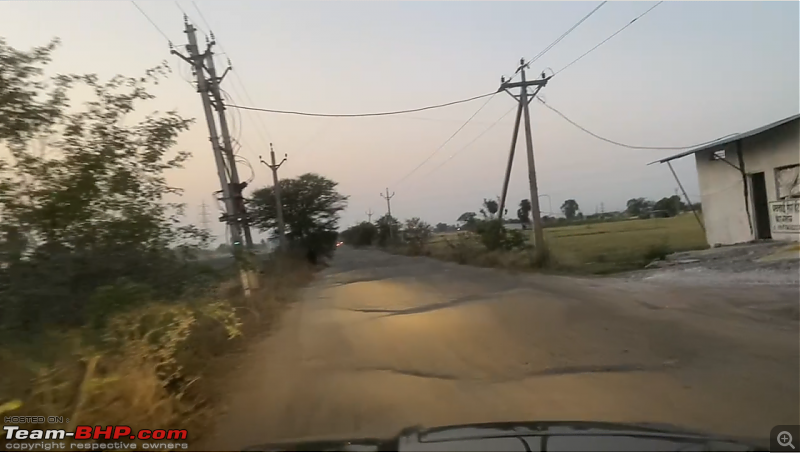 The hotel in Sanchi is well spread out with full of flowering plants and matured flowering trees. In the night the flowers from the trees gave out a smell that one typically finds in dense forests. It's an olfactory equivalent of Chopin's Nocturnes. The purpose of staying in Sanchi was to see the Stupas, visit Vidisha and the endless wheat fields in Raisen. Udaygiri caves on the hills in Vidisha is a refuge to a lot of bee-eaters. We went in the late afternoon was a lucky to see many of them returning home after a day of endless freedom. I silently observed them with binoculours. The radiance and colour of their plummage is artwork. The region is mainly sedimentary rocks, I read that the tectonic shifts around 500-600 million years ago brought the sea bed to the surface and that's how the Vindhyas and most of the other ranges in central India were formed. One can still find the sea bed fossils around the Vindhyas and the Udaygiri hills. The refuge of the bee-eaters 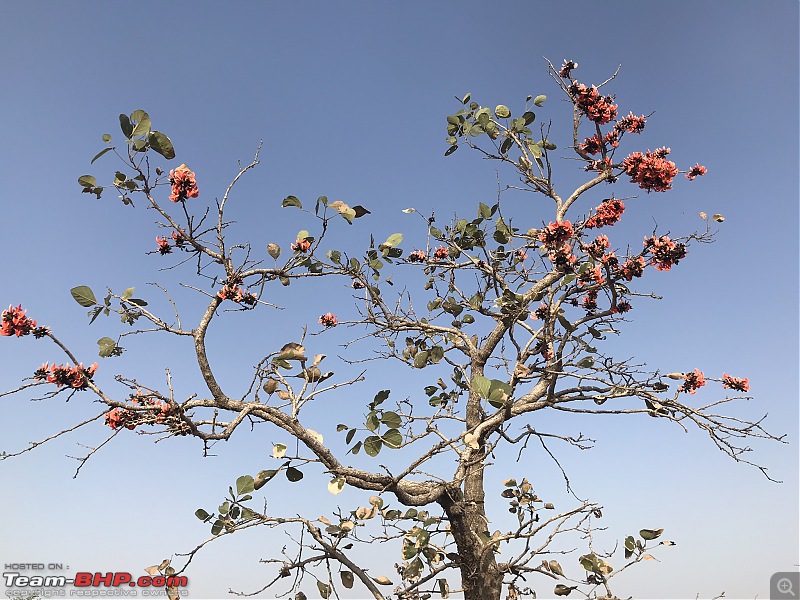 The sea bed fossils that I spoke about 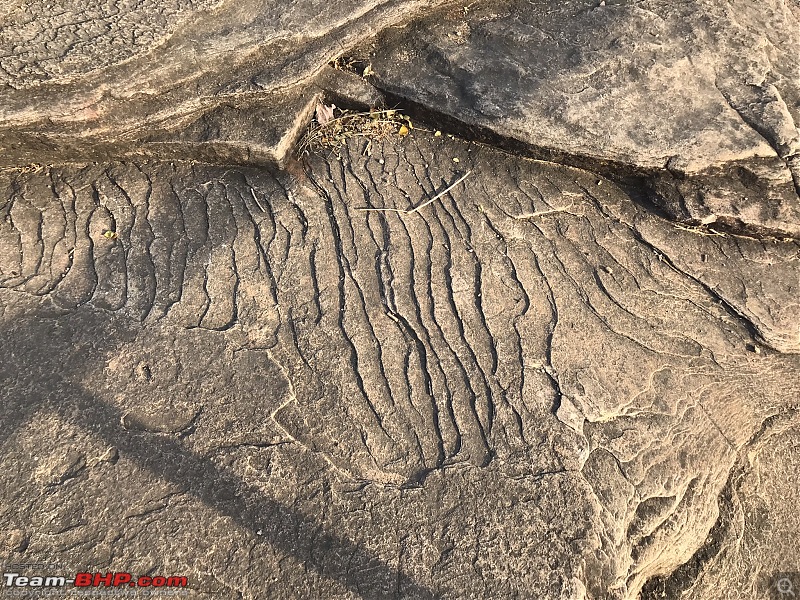 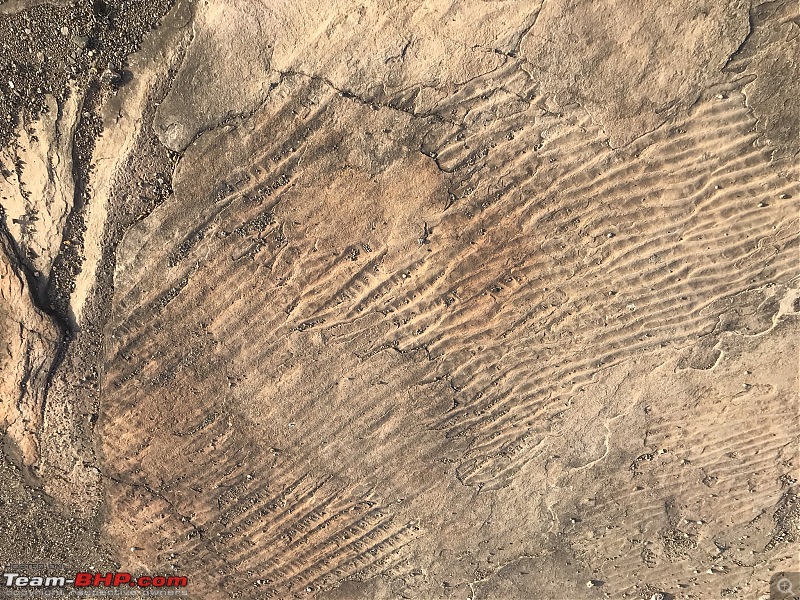 While returning went to see the Heliodorus pillar, commisioned by a Greek ambassador to became a Vaishnav. The pillar is in the middle of a village, we drove through people front yards, court yards and finally parked next to a buffalo and her calf who were having their early dinner. Again, they accomodated me thinking me as one of their kind. After studying the pillar, we went around that place. I saw a couple of village boys and girls plucking tamarind by throwing stones to a tall tamarind tree, stood next to them and relived the days that I have left far far behind. Some of them were from the village and a couple of them were cousins who came from other towns. The Heliodorus' Pillar 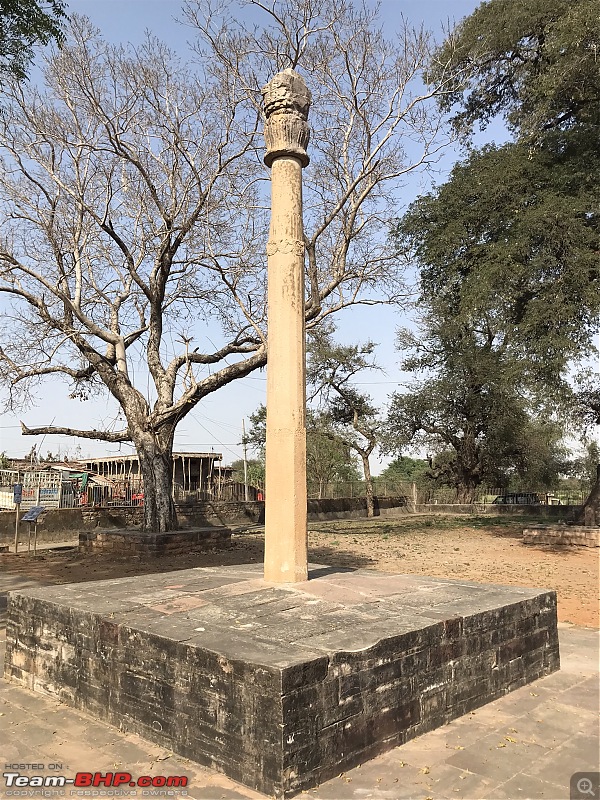 Sanchi stupa is a treasure trove for those interested in ancient history, the carvings on the panels documents events from the time of Mauryas, Gupta, Satavahanas and also the stories from the life of Budhha (from birth, kingship till his ascetic life and enlightment). Carry a binoculor if you are interested in the details as some of artwork on the four gates needs magnification when seen from the ground. Guides are available inside the complex and UPI payment routes are accepted (salute to NPCI and the digital initiatives of the government). This is something we all should be proud of, many developed countries still dont have this ease of payment and that too without a service charge by the intermediaries). While returning I drove down the village roads through the wheat fields, the reddish golden setting sun along with the dance of the wheat grasses in the winds made me count my blessings. Reminded me of the rustic scenes from "Pather Panchali" (a novel by Bibhutibushan Bandopadhay, and a film adaption of the same novel by another master craftsman Satyajit Ray). We travelled from the plains of Raisen to the plateau of Malwa heading towards Mandu/Mandav. One will cross the Tropic of Cancer while driving along the Vidisha-Bhopal highway, the place is well marked with a marble plaque and google maps. Dont forget to capture that moment. The Tropic of Cancer 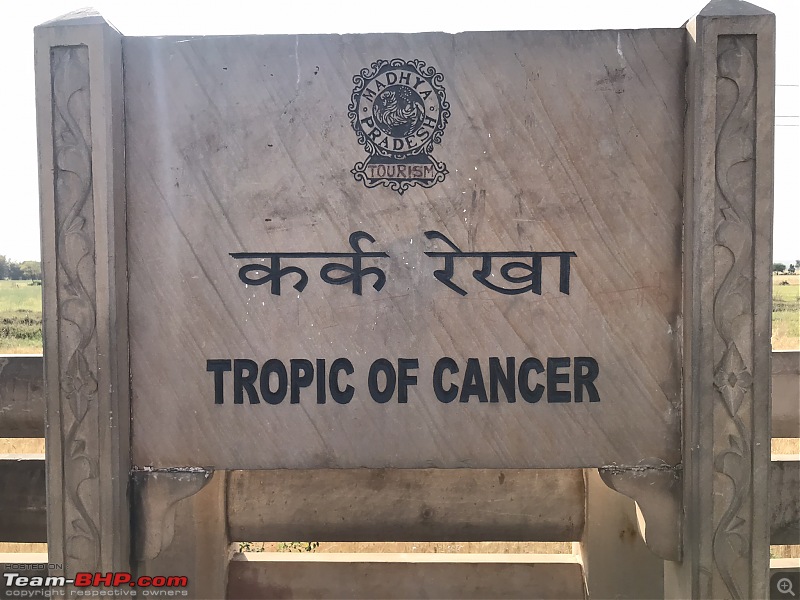 In Malwa first we went to Ujjain to meet the eternal timekeeper. We stayed there for a day. It was Rang-panchmani that day and the Mahakaaleshwar temple was relatively empty in the late afternoon. That day He was adorned in the Ardh-Narishwar Roop, I dont have words to express how the moment was when we met Him - feelings supercedes words. In the evening went to the Harashiddhi Mata mandir to see the deep-stambh being lighted. I have never seen such a thing, two huge deep-stambh are readied and lighted during the sandhya-aarti everyday by a group of volunteers. The volunteers climb the greasy and slippery towers to put oil in the hundreds of diyas and to date no one has slipped from the tower. This is bhakti, dedication and love for the Supreme. Some scenes from Harshiddhi Mata Mandir 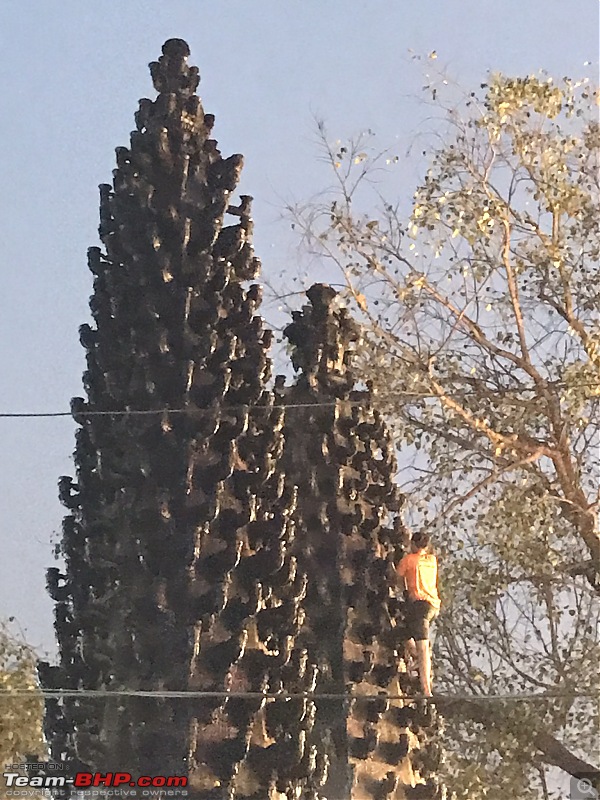 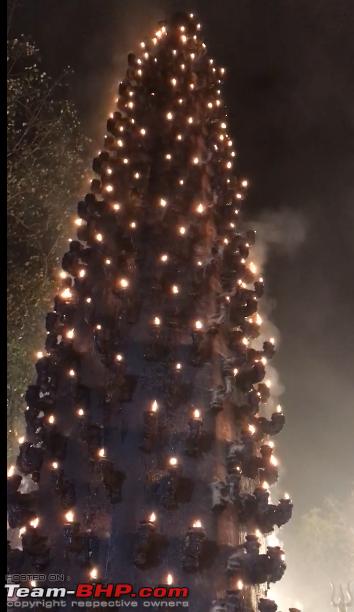 Next day drove towards Mandav, and went to all monuments constructed by the sultans of Malwa. One can take a guide from the Jama Masjid which comes first when one enters Malwa, he showed us around and told us about the films songs of the 70s that were shot here, like Sanjeev Kumar's Aandhi. Finally the guide left us at Jahaz Mahal, we sat on the top of Mahal and enjoyed the cool breeze and the sunset. The Vindhyas look beautiful from here. I was wondering how it had been hundreds of year ago when this place was the seat of the Malwa sultanate. Dont forget to visit the tomb of Hoshan Shah, even the master architect of Taj Mahal came to this structure for inspiration. One can find the interweaving of Hindu and Mughal architecture in some of the monuments which shows how one kingdom built or renovated on the erstwhile structures left behind by the previous dynasties. Ascending Malwa  The biggest attraction for us was to see the landscape and the sub Saharan Baobab trees all around Malwa. The species found here dominates in the Kalahari, this is not the one found in Madagascar (that's a different specie of the baobab). The locals revere and take care of these trees and that's the reason why the trees have multiplied in numbers over the years. Local conservation is always better because it's the indigenous people who understands the species better than anyone else coupled with the fact that it also provide livelihood either directly or indirectly. Exceptions being Madagascar which has lost 90% of its forests and the Indonesian archipelagos which has lost nearly 80% of its rain forests to commercial palm cultivation. The baobab's fruit, which is locally known as Mandu or Khorasan imli, is used by the locals. The fruit is hard cased and is about 20cms long, inside the case are the matrix of seeds coated with a thick pulp. The pulp tastes like mild imli and the seed looks eaxctly like a tamarind seed. One local told me that the just keeping the hard seed in one mouth generates saliva and this is particularly useful in summers when temperature reaches 45 degrees. Khorasan was the eastern section of the Perian empire and the western section of Central Asia. The amazing journey of a seed travelling from sub Saharan Africa to Persia and finally coming to India - changing numerous hands and finding a new home. His Majesty 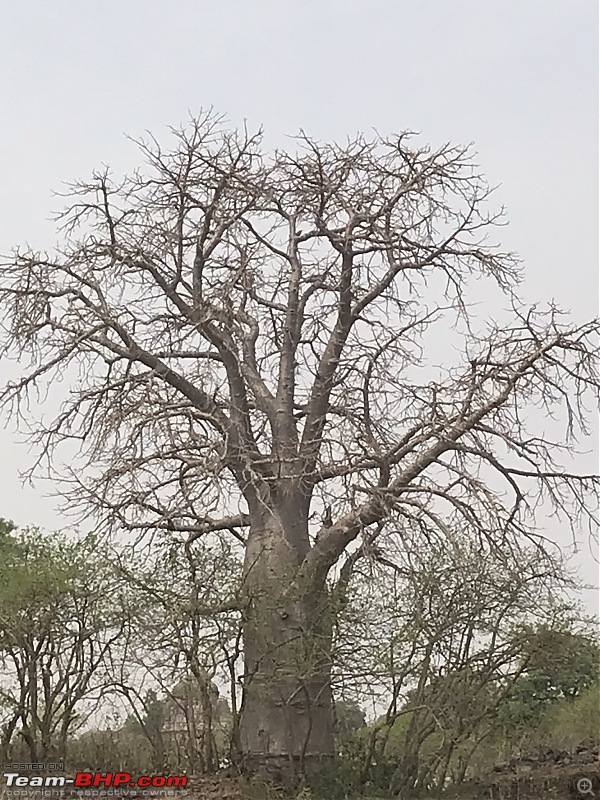 The bark which elephants in Kalahari tear and eat for water. To adapt to the dryness of the Kalahari, the bark of the tree absorbs a lot of ground water. 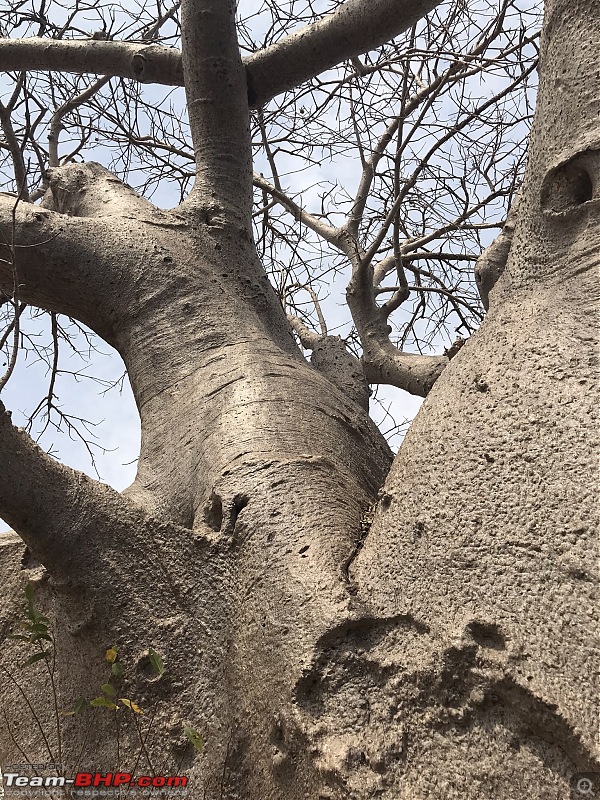 The fruit (Mandu/Khorasan imli) 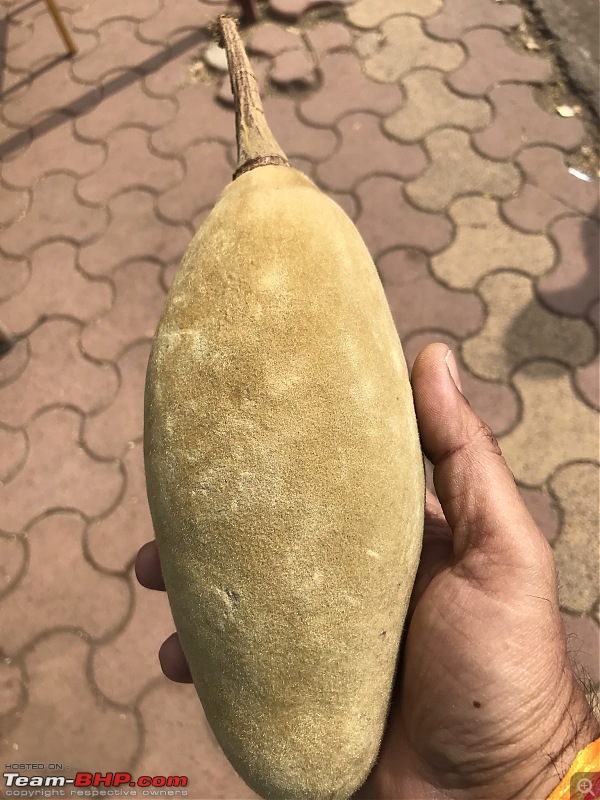 While on our way to the Roopmati's pavillion, we came across some children from the Bhil tribe, they are mainly hawkers who sell these baobad fruits, we took all of them to a ganne-ka-raas wala and treated them with a glass of freshly made sugarcane juice. I will never forget the smiles on their face while they were having it, contentedness personified, something which most of us have lost in pursuit of a better materialist life. From Maharastra till here one finds the quitessential black soil, a product of million years of erosion of Deccan traps. 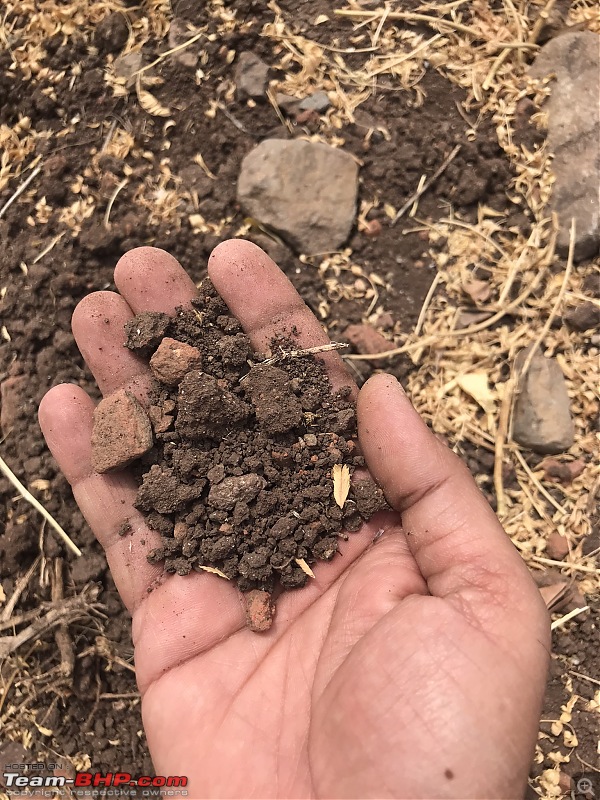 We left Mandu while the sun was setting, it was time to descent the plateau and move southeast-wards towards the Nimar plains. Within couple of hours we reached Maheswar (Khargone district) via Dhamnod (Dhar district). At Dhamnod we stopped near the town centre for a snack, we couldnt resist the kachoris and the jalebis on display at the local shops. We went to a small old sweet shop, it didnt even have any signboard, sat in one of the old wooden benches and an old man brought some kachoris and jalebis in a "donga", unfortunately it was made of polystyrene (thermocol), I was expecting a donga made out of dried sal leaves like our old days. From Dhar we entered Khargone and moved on towards Maheswar. Even before reaching the hotel we went straight to a small ghat in Maheshwar and paid our obeisance to Narmada. There was a person sitting on the banks, he told us that the ghat was called imli ghat. Ahilyabai Ghat and Fort Entrance 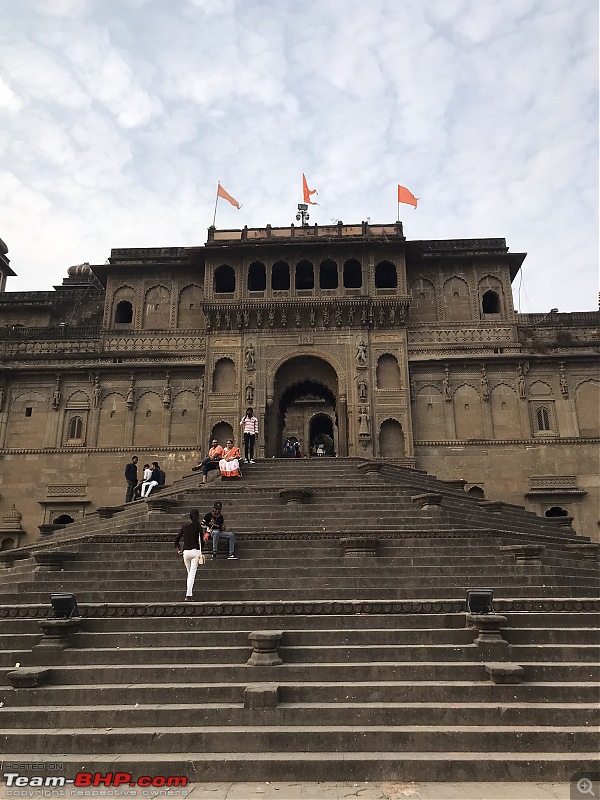 Sailing through Narmada 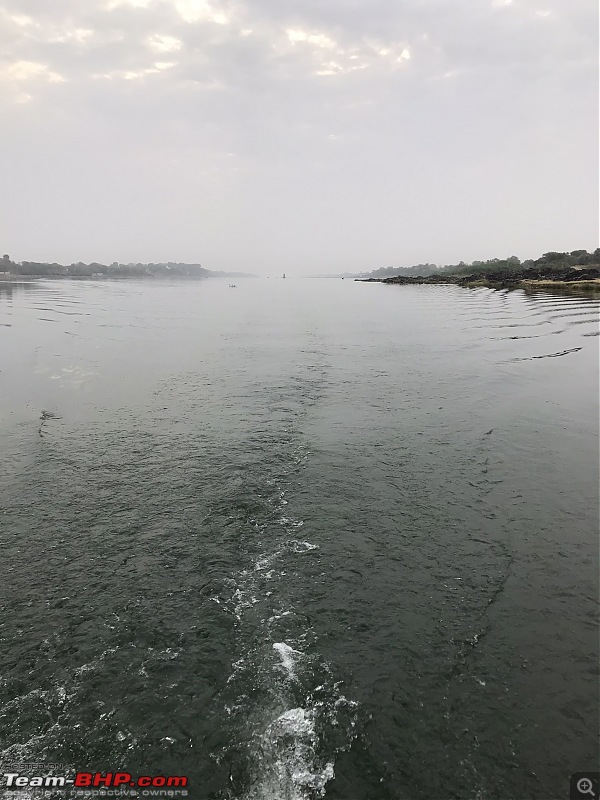 Sunset over Narmada 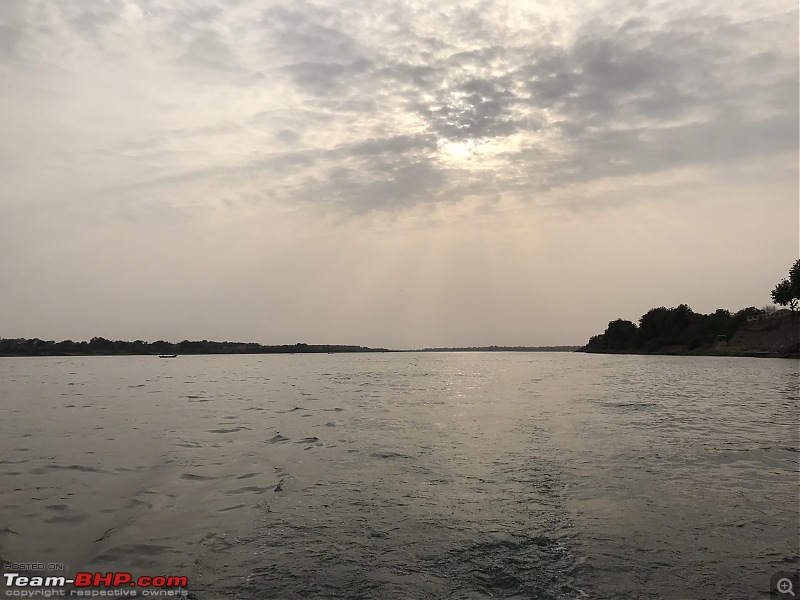 We stayed a couple of days in Maheswar just next to the banks of Narmada, even with 41-42 degrees temperature the river had a cooling breeze all day along. One of the boatsman told me that Maheshwar became quite popular after some recent Hindi films were shot there like Padman and Manikarnika. Evenings were spent in the Ahilyabai ghat in front of the Ahilya fort. One late afternoon we saw Richard Holkar and his son in the ghat with some guests from their fortress turned boutique hotel. Both the Western-sahib Holkars were dressed in kurta pyjama, and I must admit that they are extremely handsome and good looking gentlemen. If you have a satorial inclination you must pay a visit to the local stores that sells handmade Maheswari saris and Bagh prints. One merchant explained to me what it takes to make a pure Maheswari sari without any "milawat", and still the price is one-third or one-fourth the price we pay in cities. I recommend buying from the local merchants as it encourages and sustains the local community. One morning we hired a motor boat to take us to the Sahastradhara, it's a rapid 10 km upstream from Maheswar. The rocks around that place is basalt and the colour is black, our majhi-bhai told us that we should reach by 0630 and leave the place by 0830 because after that the rock surface becomes extremely hot due to the sun's heat and it's impossible to bear that heat. Even the locals dont dare to go there during daytime in the non-winter months. We boarded the motor boat from the ghat inside the hotel. The rocks around Sahastradhara are chiefly basaltic lava. One can also find finger sized holes on these rocks, these are the finger prints of the dissolved gases that came along with the lava. The water flows at very high speed and that has sharpened the rocks like swords. We sat there for several hours listening to her sounds before our majhi reminded us that we need to return. We saw several species of birds there, so bird watchers be alert - I dont remember their names, I only remember how they look and their songs. Sahastradhara 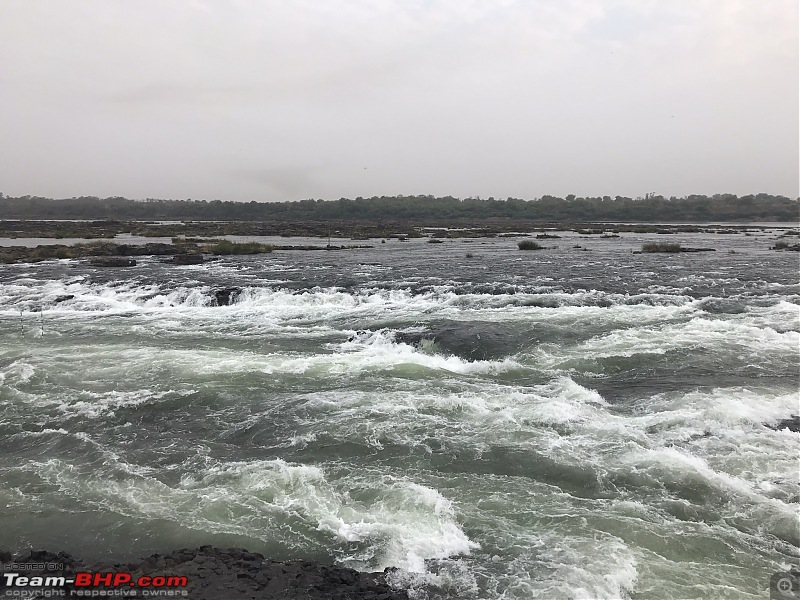 The holes left behind by the dissolved gases 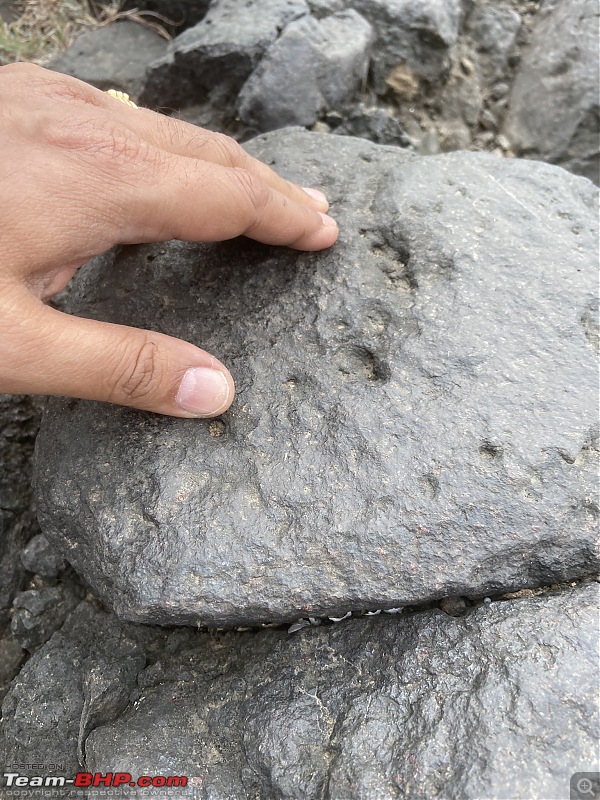 In the evening we went for a joy ride in that same boat, now downstream towards the Ahilya ghat. The purpose of staying in Maheshwar was to see Narmada and the Sahastradhara. The locals worship this river and from childhood I had heard stories of the parikrama from my mother. We were fortunate to meet couple of villagers who were doing the parikrama. Dressed in white all they had with them was a long walking stick, a putli of clothes and a jerrycan to carry Narmada water. I saw them walking through the scorching heat in Khandwa district heading towards Omkareshwar - all they had was what I have mentioned. Dedication 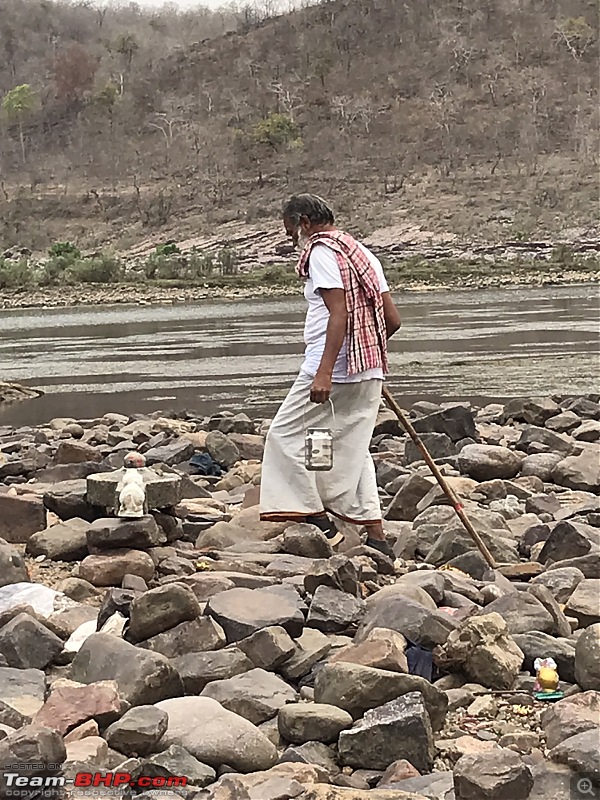 100 years back reaching Omkareshwar was a big achievement in the parikrama, because while on the way from Amarkantak the chances of survival was less, one would inevitably die of snake bites, wild animal attacks or fall into a gorge due to slippery rocks. On a similar note I remember my grandfather telling us that when he went to Kedarnath in the 1940s there were some roads which were so narrow that they had to sit on their buttocks and slide forward else walking would inevitably result in slipping into the gorge. Now one can fly to Kedarnath in a helicopter. Can divinity coexist with materialism? That's a quest yogis and sadhus pursue. I saw two sadhus doing parikrama crossing the Narmada near Omkareshwar holding two ends of a long stick, here the Narmada water level was a bit shallow owing to the withholding of water in the Omkareshwar dam. These days there are several synthetic parikramas where people travel by the day in cars and buses, walk a bit and then rest in the night in some hotel. If you can read Bangla then read an original account of the parikrama in Tapobhoomi Narmada by Sailendra Narayan Ghoshal Shastri, the book is written in formal (sadhu basha) Bangla. The facts mentioned in the book will give one goose bumps. Facts are stranger than fiction. Unfortunately the original parikrama route has been interrupted by dams, highways, human settlements and the terrain has also been changed; but in some places the ancient ambience still lives on. The rule is that mother should be always on your right side, so one starts from Amarkantak and goes till Bharuch along the southern bank, then cross the estuary and come back to Amarkantak again along the north bank. The journey took 5 to 6 years on foot. Now who has that time, online delivery companies are guaranteeing 10 minutes delivery. Is it our impatience and need for instant gratification compelling such business models or is it the other way around? Which is the cause and which is the effect? From Maheshwar we moved further south-east towards Khandwa district, our destination was Omkareshwar. The thick forest around Omkareshwar has given way to human development, it was very dissapointing to see the degrading landscapes and the contructions on and around the Narmada. The old world hills and forests are rapidy getting replaced with construction for human needs. I also saw some construction going on in the Mandhata island (that's the Om shaped river island on which the lord sits), the locals told me that some park is coming up there on top of the hills. We stayed on a hill in the bank just opposite to the temple, from the balcony one could see the temple and the island all day long. Just be careful not to leave clothes unattended in the balcony; the monkeys here have a fetish for underwear, they took some of ours away. I could only salvage one from the jungle below, probably they didnt like the style or colour and decided to leave it behind. Dont miss the Shankaracharyaji's cave in the main temple complex, and while coming down from the temple dont forget to buy peda from Sri Ganesh Bhandar, it's a shop run by a marathi and he sells some lip smacking khova peda, I prefer the softer one as they are mildly sweet, the hard ones are too sweet. You can do the Mandhata parikrama which is about 5 to 6 kms of trek, there's a proper track with many old temples where one can rest and it's guaranteed you will come back in one piece. However it's a hilly terrain so stamina is warranted. I hired a motor boat to see the rocks and forests around the island and also went till the sangam where the Narmada meets Cauvery, another of her tributary. We had to change boats because the river is being interrupted with a bridge construction, the river bed is completely dug up. Within a year or so the whole topography will change and one would not be able to take the boat till the sangam. They say "Narmada mein haar kankar mein shankar", I picked up couple of ellipsoid stones for myself as souveniers of Narmada's river bed. Our majhi-bhai was a young man doing engineering from a local college. After the boat ride we went for tea and while sipping I tried my level best to convince him to stay back and focus on ecological tourism there rather than becoming a cog-in-the-wheel in some city. Now I think I was too pedantic in my advice as I was not aware of the ground realities and the economic challenges the young man was facing. He also explained to me how much his profit would be after deducting costs and commissions; and how the economy works here. "Narmada mein haar kankar mein shankar" 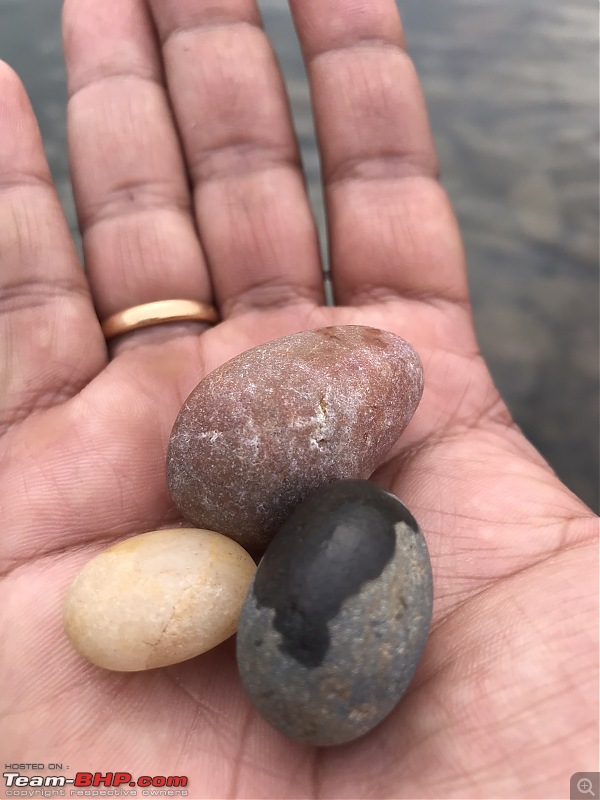 The sedimentary rocks of the Mandhata Island 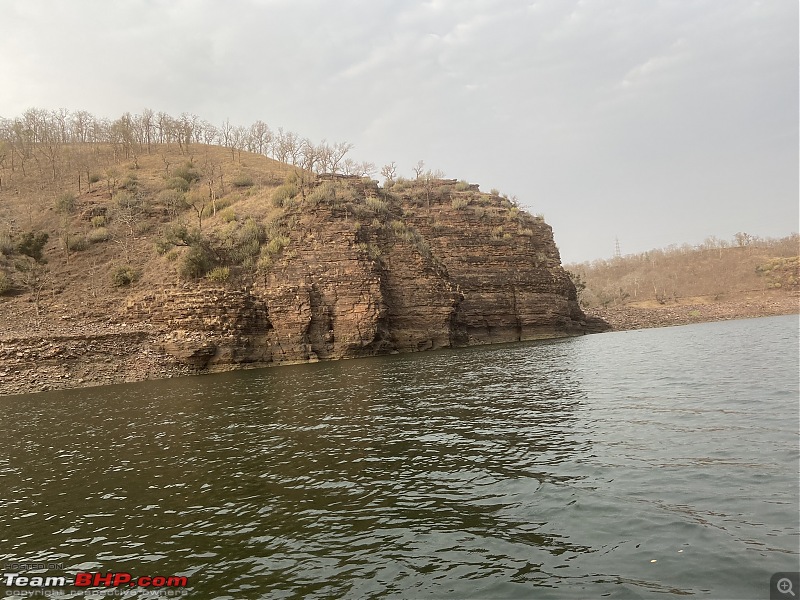 Grounded 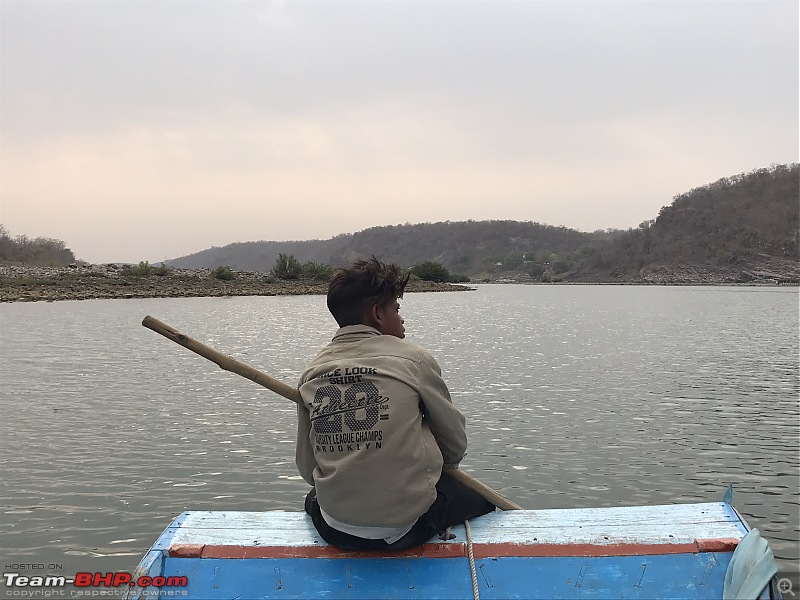 The locals told me that there was a whirlpool upstream from Omkareshwar where the water churned so fast that Shivling shaped stones used to be jettisioned from the water, they say that Shivling stones were manufactured naturally in the whirlpool's churning. Due to the construction of the Omkareshwar dam, now that place rest under water. It will be hidden from us till posterity. I didnt have the time to visit the Khandwa town, wanted to see the Ganguly brothers' (Ashok Kumar, Anoop Kumar and Kishore Kumar) ancestral house. Next day we left Omkareshwar and drove through Melghat forest towards Nagpur. The journey was intoxicating with the smell of Mahua flowers pervading the forest. I saw several tribal women collecting the flowers in bamboo baskets to make wine out of it. This is a very common scene in central India and chota-nagpur plateau around this time of the year. Most of them after collecting the flowers rested under the Mahua trees while their husbands slept in its cool shade. The Mahua flower 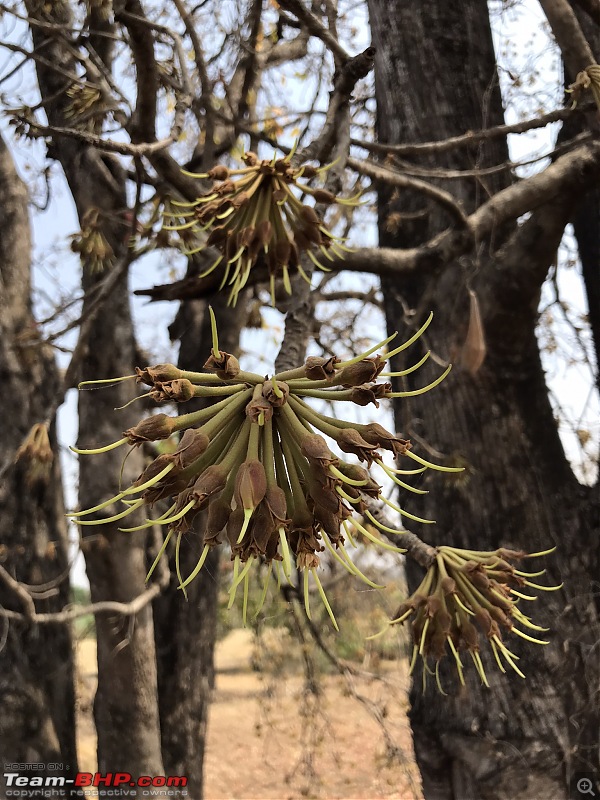 While driving down the forest, a pang of guilt weighed my soul down. This is an inevitable emotion that I have been experiencing for the last 10 years after every trip witnessing the human-nature conflict. Still there are a few who is swimming upstream and trying their level best to conserve whatever they can; their efforts can be summarised by the last two lines of Doyle Thomas' poem "Do not go gentle into that good night". Do not go gentle into that good night. Rage, rage against the dying of the light. Epilogue: Nagpur onwards it was a journey back to our home city. A world of online ordering, late evening work related conference calls, building assets, sanitizers, masks, fear of death and subsequently, annual health checkups. "Mostly it is loss that teaches us the value of things" - Arnold Schopenhauer 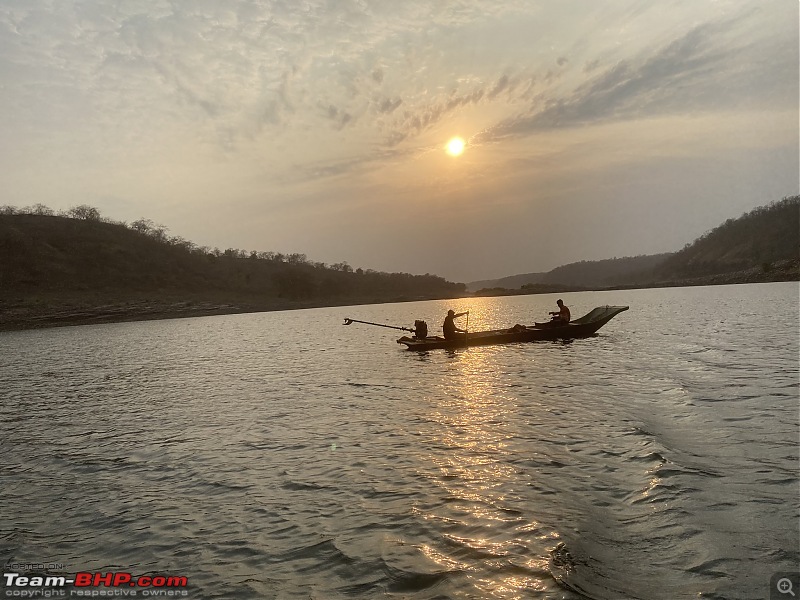 |
| |  (29)
Thanks (29)
Thanks
 |
| The following 29 BHPians Thank scorched_earth for this useful post: | Acharya, anra, antz.bin, CrAzY dRiVeR, dailydriver, Dr.AD, Dry Ice, GreenerPlanet, GTO, haisaikat, JustStarted, mallumowgli, NagaBond, nitin_knw, NomadicLife, NPX, One, parsh, PhoenixInRising, RahulC, ranjitnair77, sindabad, sukhbirST, Sumer, thirugata, UD17, V.Narayan, Vinod_nair, Voodooblaster |
| |
| | #2 |
| Distinguished - BHPian  Join Date: Jan 2008 Location: Gurgaon
Posts: 3,838
Thanked: 3,179 Times
| re: Raisen, Malwa and Nimar Road-Trip Thanks for such a lovely write up. Wile I have not done the total route but have been to most the places described in bits and pieces. The best night stay was in a tented resorts right on banks of Narmada at Maheshwar. |
| |  (1)
Thanks (1)
Thanks
 |
| The following BHPian Thanks sudev for this useful post: | scorched_earth |
| | #3 |
| BHPian Join Date: Apr 2012 Location: Delhi
Posts: 917
Thanked: 2,366 Times
| re: Raisen, Malwa and Nimar Road-Trip Wow, that's an excellent planning resource along with some lucrative pictures. Thank you for posting. Just want to check the best way of booking MP tourism hotels. And how are they maintained? And what's the best time to plan such a trip, with the goals of not finding crowds and avoiding inclement weather (heat / rains / poor visibility)? |
| |  (1)
Thanks (1)
Thanks
 |
| The following BHPian Thanks ajayc123 for this useful post: | scorched_earth |
| | #4 | |
| BHPian Join Date: Aug 2022 Location: Bengaluru
Posts: 54
Thanked: 269 Times
| re: Raisen, Malwa and Nimar Road-Trip Quote:
I always book directly, it's 100% reliable and instant confirmation by email and SMS. Avoid June-August due to rains, there are chances of getting stuck due to floods. Winter is crowded, and summers are scorching - that leaves us with autumn and spring. | |
| |  (2)
Thanks (2)
Thanks
 |
| The following 2 BHPians Thank scorched_earth for this useful post: | ajayc123, anra |
| | #5 | |
| BHPian Join Date: Mar 2021 Location: Bhopal
Posts: 35
Thanked: 69 Times
| Re: Raisen, Malwa and Nimar Road-Trip Quote:
Most of the properties are very well maintained and while booking if you face any issue, on the site you will can also find the name and number of the manager of that property, whom you can call directly. Regarding time to visit, all the National Parks are closed during rains, so if you plan to visit them, the best time for spotting is summers as tigers and other wildlife can be spotted near water bodies. For other places and plains, winters are good. Highways are mostly good in MP, so mile munching is easy. | |
| |  (1)
Thanks (1)
Thanks
 |
| The following BHPian Thanks Mannu for this useful post: | anra |
| | #6 |
| BHPian Join Date: Nov 2011 Location: Hyderabad
Posts: 34
Thanked: 143 Times
| Re: Raisen, Malwa and Nimar Road-Trip "Darun". Thats the only word that comes to my mind in Bangla after reading your piece. It is extremely evocative and surrealy transformative with respect to the frame of mind of the reader. I have also been to most of these places (and temporarily lived at a place on the Malwa Plateau) in bits and pieces but the symphony is in the continuity I guess. You must visit upper Narmada valley from Amarkantak to Jabalpur. It is still relatively untouched and Jabalpur is a beautiful place. One may plan till Pachmarhi (where also I have lived for a year) and then the Satpura Tiger Reserve. And the smell of Mahua took my breath away and transposed me at least three decades into the past with images of childhood, cycling around the hills and forests of the Chotanagpur Plateau. Thank you sir and take a bow. |
| |  (2)
Thanks (2)
Thanks
 |
| The following 2 BHPians Thank Air Cav for this useful post: | anra, scorched_earth |
| | #7 |
| BHPian Join Date: Jul 2022 Location: Garden City
Posts: 43
Thanked: 44 Times
| Re: Raisen, Malwa and Nimar Road-Trip Thanks for this wonderful write up with some thoughts for mind. The pictures are nice, depicting the beautiful journey which you undertook. Maybe someday I will traverse this path. I can relate to those pictures concerning the small pebbles, which have been shaped by water over time. I have a habit of collecting stones from river beds/water bodies when I visit a place. This reminds me of the place when I look at the piece after some time. You can feel the air on your skin and the noise of water reverberating in your ears. You have also covered all the important points in this journey which will help a fellow traveler who is planning to visit these places. Looking forward to view more write ups and pictures from you. Thanks once again. |
| |  (1)
Thanks (1)
Thanks
 |
| The following BHPian Thanks PhoenixInRising for this useful post: | scorched_earth |
| | #8 | |
| BHPian Join Date: Aug 2022 Location: Bengaluru
Posts: 54
Thanked: 269 Times
| Re: Raisen, Malwa and Nimar Road-Trip Quote:
I have this travel plan lined up and the route is exactly as you have suggested (including Pachmarhi). I can very well relate to your childhood memories of cycling; especially the feeling of freedom while the wind brushing past oneself. | |
| |  ()
Thanks ()
Thanks
 |
| | #9 | |
| BHPian Join Date: Aug 2022 Location: Bengaluru
Posts: 54
Thanked: 269 Times
| Re: Raisen, Malwa and Nimar Road-Trip Quote:
I hope that someday you will take up this journey and discover the land in your own unique way. | |
| |  (1)
Thanks (1)
Thanks
 |
| The following BHPian Thanks scorched_earth for this useful post: | PhoenixInRising |
| | #10 | |
| BHPian Join Date: Dec 2021 Location: Indore
Posts: 38
Thanked: 52 Times
| Re: Raisen, Malwa and Nimar Road-Trip Quote:
| |
| |  (1)
Thanks (1)
Thanks
 |
| The following BHPian Thanks nitin_knw for this useful post: | scorched_earth |
| | #11 | |
| BHPian Join Date: Aug 2022 Location: Bengaluru
Posts: 54
Thanked: 269 Times
| Re: Raisen, Malwa and Nimar Road-Trip Quote:
No I didnt cross Khandwa town, missed it, I will keep your suggestion in mind. | |
| |  (1)
Thanks (1)
Thanks
 |
| The following BHPian Thanks scorched_earth for this useful post: | anra |
| |
| | #12 |
| Senior - BHPian Join Date: Jan 2006 Location: NYC/MAA
Posts: 1,430
Thanked: 603 Times
| Re: Raisen, Malwa and Nimar Road-Trip I took the journey with you visually. Greta travelogue and thanks for highlighting this region of MP. There's a lot we should know about our own country. |
| |  (1)
Thanks (1)
Thanks
 |
| The following BHPian Thanks nickatnite for this useful post: | scorched_earth |
| | #13 | |
| BHPian Join Date: Aug 2022 Location: Bengaluru
Posts: 54
Thanked: 269 Times
| Re: Raisen, Malwa and Nimar Road-Trip Quote:
For me one lifetime is not enough to discover this land. It has so many dimensions to explore - history, geography, anthropology and gastronomy. | |
| |  (1)
Thanks (1)
Thanks
 |
| The following BHPian Thanks scorched_earth for this useful post: | anra |
 |


